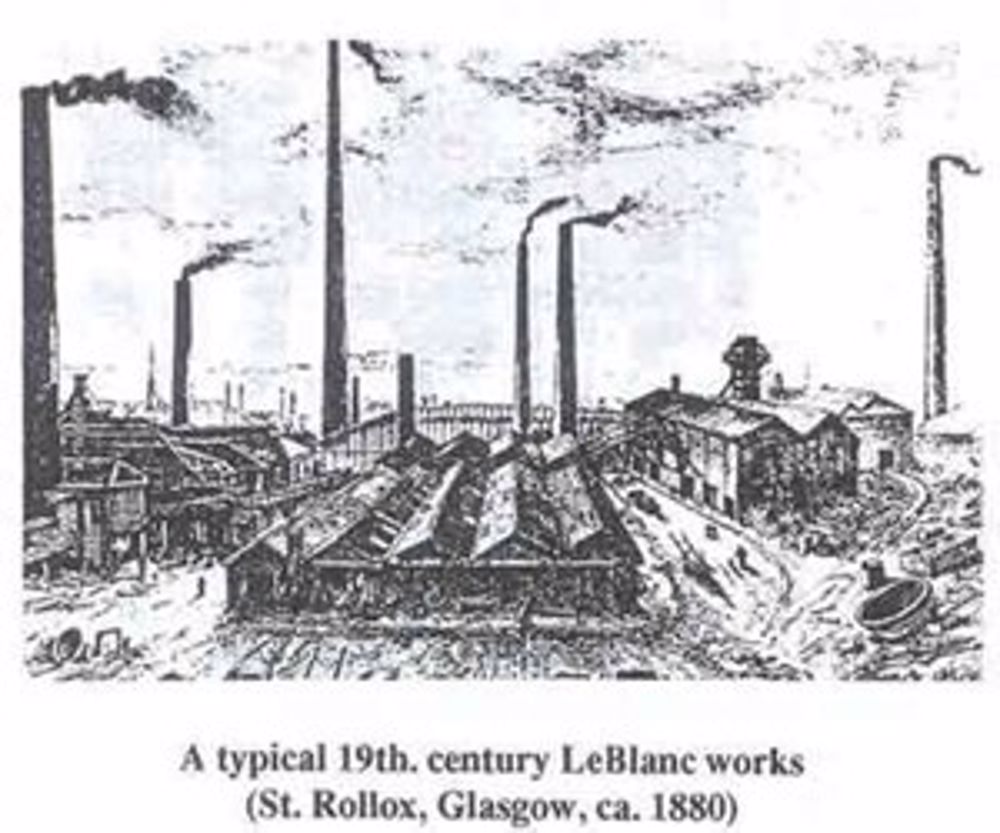The Stinking History of Washing Soda

Sodium carbonate (Na2CO3) is a very useful compound, in this form (soda ash) or the hydrate Na2CO3.10H20 (washing soda – it softens water by precipitating out calcium ions).
It was in great demand in the 19th century both for domestic washing and for products such as soap, glass and many chemicals. It used to be made from the ashes of plants, but industrially it is made from two common materials, salt NaCl, and limestone CaCO3.
2NaCl + CaCO3 = Na2CO3 + CaCl2
Unfortunately, this reaction does not work – or rather it does in reverse. Na2CO3 and CaCl2 both dissolve in water. If they are mixed, solid CaCO3 precipitates, leaving a solution of salt.
Enter French Chemist Nicolas Leblanc with an ingenious series of reactions.
This process has the following steps:
2NaCl + H2SO4 = Na2SO4 + 2HCl↑
Na2SO4 + 2C + heat = Na2S + 2CO2↑ (the carbon was coal)
Na2S + CaCO3 = Na2CO3 + CaS
The purified sodium carbonate was the only product, HCl and CaS were waste. The HCl was simply vented to the atmosphere. The very tall chimneys in the picture (up to 100 m) were to disperse it. Of course, it came down as acid rain.
The CaS was just dumped on nearby fields, where rain caused it to release smelly and poisonous H2S.
CaS + 2HCl = CaCl2 + H2S
This was in addition to the smoke from the burning coal.
It was disgust at these plants and others in the chemical industry that led an inspector George E. Davis to effectively invent modern chemical engineering as a science-based way of efficient and responsible practice, very much concerned with environmental issues.
So how was it made better?
The first stage was capturing the HCl by dissolving it in water sprays. This removed 95% of these fumes. Initially the liquid was often piped into the river, with resultant damage.
However, the hydrochloric acid could be used in other industrial processes, and was sometimes used to make bleaching powder on the same site.
The sulfur in CaS was recovered to be used in the manufacture of sulphuric acid, one of the starting ingredients (recycling of the element – common today).
A better process was invented by Belgian chemist Ernest Solvay from the same main feedstocks, and is now the main one. It uses NH3 from the Haber-Bosch process instead of H2SO4.
NaCl + CO2 + NH3 + H2O = NaHCO3 + NH4Cl
2NaHCO3 + heat = Na2CO3 + CO2 + H2O (CO2 can be recycled)
2NH4Cl + CaO = 2NH3 + CaCl2 + H2O (NH3 recycled.)
And where does the CaO come from?
CaCO3 + heat = CaO + CO2 (CO2 recycled).
This illustrates progress in environmental protection
- Treating releases to reduce pollution
- Finding uses for waste
- Better processes – recycling, less waste, energy, cost,
We are now working towards ones that are more sustainable, but this cannot be left to the industry alone. Society in the form of consumers and politicians have also to play their part to minimize waste and assist in recycling.